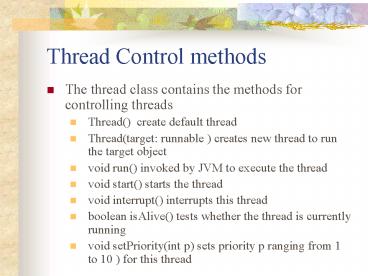Thread Control methods - PowerPoint PPT Presentation
1 / 10
Title:
Thread Control methods
Description:
boolean isAlive() tests whether the thread is currently running ... of Java 2, these methods are deprecated ( or outdated) because they are known to ... – PowerPoint PPT presentation
Number of Views:22
Avg rating:3.0/5.0
Title: Thread Control methods
1
Thread Control methods
- The thread class contains the methods for
controlling threads - Thread() create default thread
- Thread(target runnable ) creates new thread to
run the target object - void run() invoked by JVM to execute the thread
- void start() starts the thread
- void interrupt() interrupts this thread
- boolean isAlive() tests whether the thread is
currently running - void setPriority(int p) sets priority p ranging
from 1 to 10 ) for this thread
2
Thread control methods
- void join() wait for this thread to finish
- void yield() causes this thread to temporarily
pause and allow other threads to execute - boolean isInterrupted() tests if the current
thread has been interrupted - Thread currentThread() returns a reference to the
currently executing thread object
3
Note
- The Thread class also contains the stop(),
suspend() and resume() methods. As of Java 2,
these methods are deprecated ( or outdated)
because they are known to be inherently unsafe. - Instead of using the stop() method, you should
assign null to a Thread variable to indicate that
it is stopped.
4
yield()
- You can use yield() method to temporarily release
time for other threads. - For example, in run method,
- public void run()
- for( int I 1 I lt lastNum I)
- System.out.print( I)
- Thread.yield()
- Every time a number is printed, the print100
thread is yield. So each number is followed by
some characters
5
Sleep()
- The sleep(long mills) method puts the thread to
sleep for the specified time in milliseconds. - Example, in run() method
- public void run()
- for( int I 1 I lt lastNum I)
- System.out.print( I)
- try
- if( Igt50) Thread.sleep(1)
- catch( InterruptedException ex)
- Every time a number (gt50) is printed, the
print100 thread is put to sleep for 1 millisecond
6
join()
- Use join method to force one thread to wait for
another thread to finish. - For example, in run() method
- public void run()
- for( I 1 Ilt lastNum I)
- System.out.print( I)
- try
- if ( I 50 ) printA.join()
- catch (InterruptedException ex)
- The number from 50 to 100 are printed after
thread printA is finished. - Who force who? Who wait for who?
- Current thread wait for thread printA
7
Thread state
- Thread can be in one of five states
- New, Ready, Running, Blocked, finished
- New when a thread is created
- Ready after calling start(). A thread is
runnable but may not be running. The OS had to
allocate time - Running A ready thread begins executing
- Blocked several reasons, it can be reactivated
- it may have invoked the join(), sleep()
- Other thread may have invoked these methods
- May be waiting for an I/O operation to finish
- Finished if it completes the execution of its
run() method
8
Find out state
- isAlive() method is used to find out the state of
a thread. It returns true if a thread is in the
Ready, Blocked, or Running state it returns
false if a thread is new and has not started or
if it is finished - Interrupt() method interrupts a thread in the
following way - If a thread is currently in the Ready or Running
state, its interripted falg is set - If a thread is currently blocked, it is awakened
and enters the Ready state, and a
java.lang.InterruptedException is thrown
9
Thread priorities
- Java assigns every thread a priority
- By default, a thread inherits the priority of the
thread that spawned it - Increase or decrease the priority of any thread
by using setPriority(int) method - Priorities are numbers 1 -10
- Thread class has int constants MIN_PRIORTY,
NORM_PRIORITY and MAX_PRIORITY representing 1,5
and 10. - JVM picks highest priority
- Lower-priority thread can run only when no
higher-priority threads are running
10
Thread group
- A thread group is a set of thread
- You can group them and perform operation on
entire group - Use the ThreadGroup constructor to construct a
thread group - ThreadGroup g new ThreadGroup(Thread
Group) - This create a group with name Thread Group
- Place a thread in the group
- Thread t new Thread(g, newThreadClass(),
label for the thread) - To find out how many threads in a group are
currently running - Ssytem.out.println(The number of thread
in the group g.activeCount()) - Each thread belongs to a thread group. By
default, a newly created thread becomes a member
of the current thread group that spawned it. To
find which group it belongs to, use the
getThreadGroup() method































